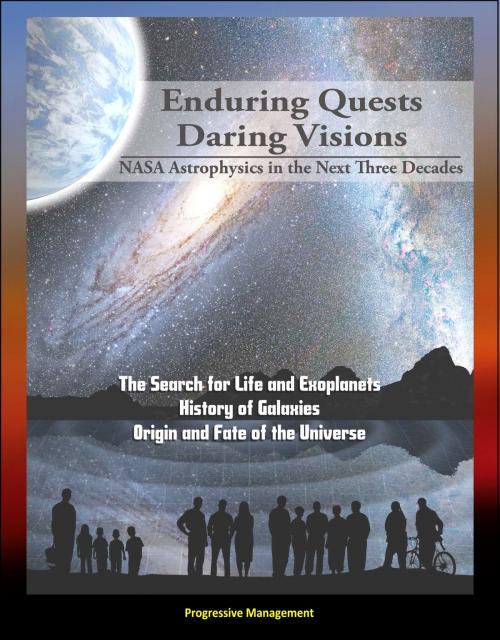Enduring Quests, Daring Visions: NASA Astrophysics in the Next Three Decades - The Search for Life and Exoplanets, History of Galaxies, Origin and Fate of the Universe
Nonfiction, Science & Nature, Technology, Aeronautics & Astronautics, Science, Physics, Astronomy| Author: | Progressive Management | ISBN: | 9781310395499 |
| Publisher: | Progressive Management | Publication: | January 14, 2014 |
| Imprint: | Smashwords Edition | Language: | English |
| Author: | Progressive Management |
| ISBN: | 9781310395499 |
| Publisher: | Progressive Management |
| Publication: | January 14, 2014 |
| Imprint: | Smashwords Edition |
| Language: | English |
This roadmap, released in early 2014, presents a science-driven 30-year vision for the future of NASA Astrophysics that builds on recent remarkable discoveries to address three defining questions: Are we alone? How did we get here? How does the universe work?
Enduring Quests * Are We Alone? * The Exoplanet Zoo * What Are Exoplanets Like? * The Search for Life * Activities by Era * How Did We Get Here? * Stellar Life Cycles and the Evolution of the Elements * The Archaeology of the Milky Way and Its Neighbors * The History of Galaxies * Activities by Era * How Does Our Universe Work? * The Origin and Fate of the Universe * Revealing the Extremes of Nature * Listening to the Cosmos * Activities by Era * Public Engagement: Connecting Through Astronomy * The continuum of astronomy learners * Audiences: From online to one-on-one * Realizing the Vision: Notional Missions and Technologies * Formative Era * The Visionary Era * Cross-cutting, Game-changing Technologies * Science Summary * Technology Summary * Daring Visions * Acronyms
Seeking answers to these age-old questions are Enduring Quests of humankind. The coming decades will see giant strides forward in finding earthlike habitable worlds (exoEarths), in understanding the history of star and galaxy formation and evolution, and in teasing out the fundamental physics of the cosmos. * Different astronomical phenomena are typically most prominent in distinct regions of the electromagnetic spectrum: young, dust-enshrouded stars in the far-infrared; older stars and galaxies in visible and near-optical wavelengths; star-forming regions in the ultraviolet, and the million-degree gas of galaxy clusters and black hole accretion disks in X-rays. In addition to spanning the electromagnetic spectrum, the roadmap missions will open a revolutionary new window on the cosmos by detecting gravitational waves, ripples of space-time that emanate from colossal events like the merging of two black holes. These scientific investigations and their enabling space missions are described here in three broad categories of time: the Near-Term Era, defined by missions that are currently flying or planned for the coming decade; the Formative Era, with notional missions (referred to here as "Surveyors") that could be designed and built in the 2020s; and the Visionary Era of technologically advanced missions (referred to as "Mappers") for the 2030s and beyond.
The past three decades have seen prodigious advances in astronomy and astrophysics. We have discovered thousands of planets around other stars, revealing a startling diversity of planetary systems and demonstrating that our own solar system is one of many billions across the galaxy. We have mapped the life cycle of stars from their formation in nearby stellar nurseries to their sometimes explosive deaths. We have tallied supermassive black holes weighing millions to billions of times the Sun's mass, finding them in the centers of most big galaxies, where they gorge on gas and stars and blast superheated material into their environments. We have traced the growth and transformation of galaxies from young chaotic shreds a billion years after the Big Bang to the majestic forms they display today. We have established, using precision cosmological measurements, a well-tested account of the Big Bang model's underlying physics. The current picture points to a universe where an early epoch of inflation established uniformity over a vast horizon, where dark matter dominates the gravitational forces that provide the underlying framework of cosmic structure, and where dark energy drives expansion at an ever-accelerating rate.
This roadmap, released in early 2014, presents a science-driven 30-year vision for the future of NASA Astrophysics that builds on recent remarkable discoveries to address three defining questions: Are we alone? How did we get here? How does the universe work?
Enduring Quests * Are We Alone? * The Exoplanet Zoo * What Are Exoplanets Like? * The Search for Life * Activities by Era * How Did We Get Here? * Stellar Life Cycles and the Evolution of the Elements * The Archaeology of the Milky Way and Its Neighbors * The History of Galaxies * Activities by Era * How Does Our Universe Work? * The Origin and Fate of the Universe * Revealing the Extremes of Nature * Listening to the Cosmos * Activities by Era * Public Engagement: Connecting Through Astronomy * The continuum of astronomy learners * Audiences: From online to one-on-one * Realizing the Vision: Notional Missions and Technologies * Formative Era * The Visionary Era * Cross-cutting, Game-changing Technologies * Science Summary * Technology Summary * Daring Visions * Acronyms
Seeking answers to these age-old questions are Enduring Quests of humankind. The coming decades will see giant strides forward in finding earthlike habitable worlds (exoEarths), in understanding the history of star and galaxy formation and evolution, and in teasing out the fundamental physics of the cosmos. * Different astronomical phenomena are typically most prominent in distinct regions of the electromagnetic spectrum: young, dust-enshrouded stars in the far-infrared; older stars and galaxies in visible and near-optical wavelengths; star-forming regions in the ultraviolet, and the million-degree gas of galaxy clusters and black hole accretion disks in X-rays. In addition to spanning the electromagnetic spectrum, the roadmap missions will open a revolutionary new window on the cosmos by detecting gravitational waves, ripples of space-time that emanate from colossal events like the merging of two black holes. These scientific investigations and their enabling space missions are described here in three broad categories of time: the Near-Term Era, defined by missions that are currently flying or planned for the coming decade; the Formative Era, with notional missions (referred to here as "Surveyors") that could be designed and built in the 2020s; and the Visionary Era of technologically advanced missions (referred to as "Mappers") for the 2030s and beyond.
The past three decades have seen prodigious advances in astronomy and astrophysics. We have discovered thousands of planets around other stars, revealing a startling diversity of planetary systems and demonstrating that our own solar system is one of many billions across the galaxy. We have mapped the life cycle of stars from their formation in nearby stellar nurseries to their sometimes explosive deaths. We have tallied supermassive black holes weighing millions to billions of times the Sun's mass, finding them in the centers of most big galaxies, where they gorge on gas and stars and blast superheated material into their environments. We have traced the growth and transformation of galaxies from young chaotic shreds a billion years after the Big Bang to the majestic forms they display today. We have established, using precision cosmological measurements, a well-tested account of the Big Bang model's underlying physics. The current picture points to a universe where an early epoch of inflation established uniformity over a vast horizon, where dark matter dominates the gravitational forces that provide the underlying framework of cosmic structure, and where dark energy drives expansion at an ever-accelerating rate.















